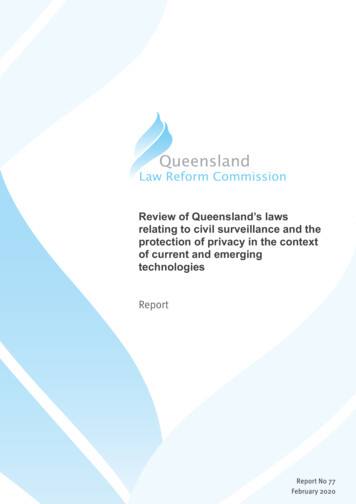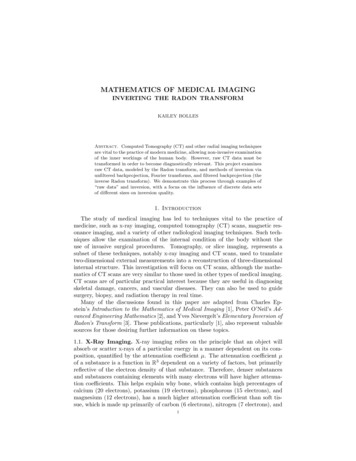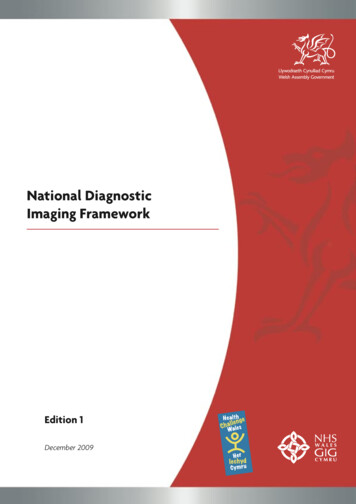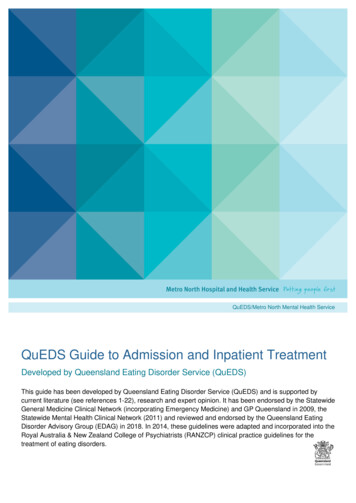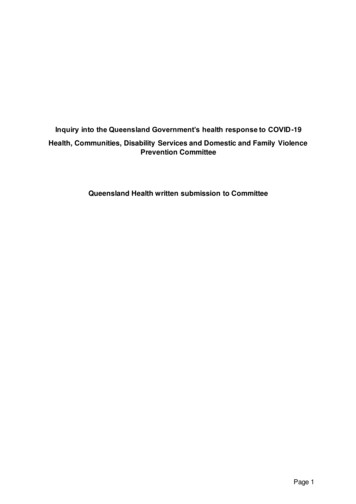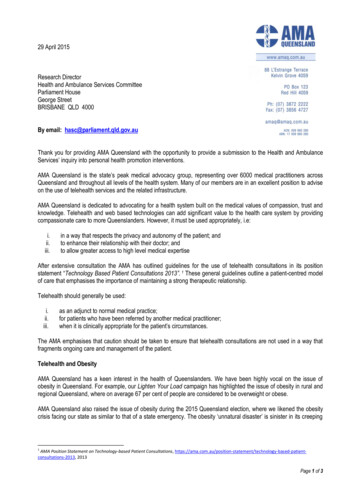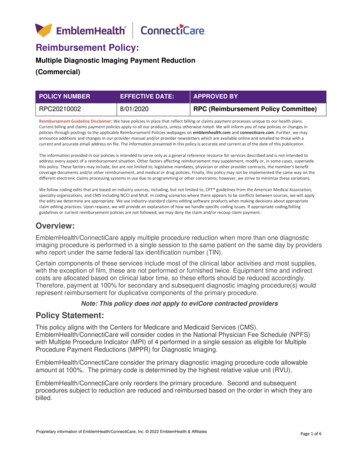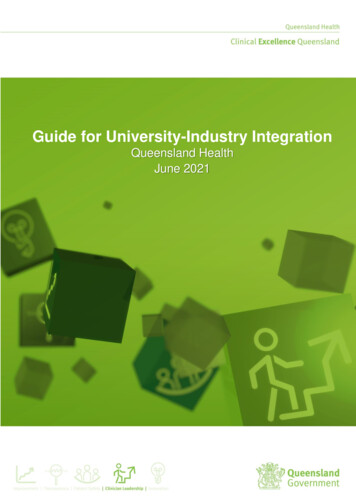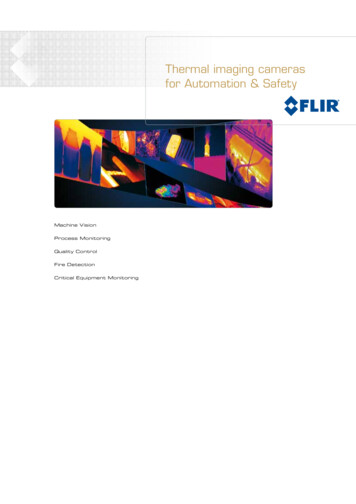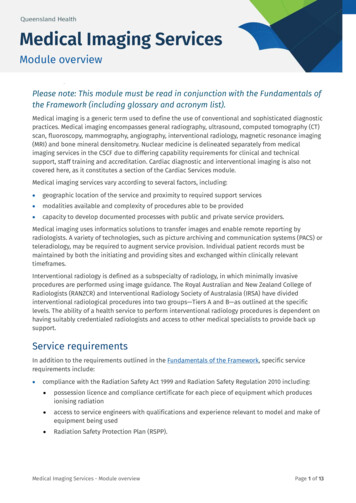
Transcription
Medical Imaging ServicesModule overviewMedicPlease note: This module must be read in conjunction with the Fundamentals ofthe Framework (including glossary and acronym list).Medical imaging is a generic term used to define the use of conventional and sophisticated diagnosticpractices. Medical imaging encompasses general radiography, ultrasound, computed tomography (CT)scan, fluoroscopy, mammography, angiography, interventional radiology, magnetic resonance imaging(MRI) and bone mineral densitometry. Nuclear medicine is delineated separately from medicalimaging services in the CSCF due to differing capability requirements for clinical and technicalsupport, staff training and accreditation. Cardiac diagnostic and interventional imaging is also notcovered here, as it constitutes a section of the Cardiac Services module.Medical imaging services vary according to several factors, including: geographic location of the service and proximity to required support services modalities available and complexity of procedures able to be provided capacity to develop documented processes with public and private service providers.Medical imaging uses informatics solutions to transfer images and enable remote reporting byradiologists. A variety of technologies, such as picture archiving and communication systems (PACS) orteleradiology, may be required to augment service provision. Individual patient records must bemaintained by both the initiating and providing sites and exchanged within clinically relevanttimeframes.Interventional radiology is defined as a subspecialty of radiology, in which minimally invasiveprocedures are performed using image guidance. The Royal Australian and New Zealand College ofRadiologists (RANZCR) and Interventional Radiology Society of Australasia (IRSA) have dividedinterventional radiological procedures into two groups—Tiers A and B—as outlined at the specificlevels. The ability of a health service to perform interventional radiology procedures is dependent onhaving suitably credentialed radiologists and access to other medical specialists to provide back upsupport.Service requirementsIn addition to the requirements outlined in the Fundamentals of the Framework, specific servicerequirements include: compliance with the Radiation Safety Act 1999 and Radiation Safety Regulation 2010 including: possession licence and compliance certificate for each piece of equipment which producesionising radiation access to service engineers with qualifications and experience relevant to model and make ofequipment being used Radiation Safety Protection Plan (RSPP).Medical Imaging Services - Module overviewPage 1 of 13
Workforce requirementsIn addition to requirements outlined in the Fundamentals of the Framework, specific workforcerequirements include: appointed radiation safety officer qualified radiology medical physicist accessible for consultation on optimisation, dosimetry,quality assurance and additional matters relating to radiation protection in medical exposure where MRI services are available, MRI safety training is provided staff with required competencies in order to administer contrast and manage allergic reactions where radiographers are not available or require support in rural and remote locations, x-rayoperators may provide a limited general x-ray imaging service. (X-ray operators complete a shorttraining course and require ongoing training and support from a qualified radiographer who takeson the role of radiographic advisor).Specific risk considerationsIn addition to risk management outlined in the Fundamentals of the Framework, specific riskconsiderations for medical imaging services include: maintenance of compliance with the Commonwealth Department of Health Capital Sensitivity forDiagnostic Imaging Equipment.Medical Imaging Services - Module overviewPage 2 of 13
Medical ImagingservicesServicedescriptionLevel 1Level 2Level 3Level 4 provides low-riskambulatory careservices duringbusiness hours andmay provide somelimited after-hoursservices. involves a mobile orfixed, general x-ray unitand is predominantlydelivered by x-rayoperators. computed radiographyequipment is availableto acquire images andfacilitate imagetransfer. must be able to provideresuscitation andstabilisation of patientemergencies untiltransfer or retrieval toa back-up healthfacility. must have documentedprocesses with a publicor suitably licensedprivate health facilityfor patient referral andtransfer to/from ahigher level of service. transfer occurs within24 hours. provides a low-riskambulatory care andinpatient service. predominantlydelivered by x-rayoperators supported bysole radiographer. may be a designatedroom on-site with afixed x-ray unit andcomputed radiography. depending on range ofservices provided at thefacility (e.g. dayhospital), a mobileimage intensifier maybe the only modalityavailable. access to ultrasoundfor non-complexconditions or anoutreach service maybe available. may have diagnosticultrasound services formore complexconditions, which mayinclude obstetric andbreast ultrasound. sites may performexaminations involvingcontrast. CT service may also beavailable off-site andprovided underarrangement withanother facility. may provide fixed-roomfluoroscopy, on-site CTservices, complexultrasound,interventionalradiology Tier A, andmammography andinterventional breastimaging services butnot all modalitiesdescribed in thissection will be providedin all services; however,where they are,minimum requirementsfor provision of safeimaging service aredescribed. may provide CT serviceseven if supervisingradiologist not on-siteand must developdocumented CTprocesses withradiologist to providenecessary level ofsupervision andsupport to the service. protocols also requiredthat identify:- clinical indications forconducting CT- indications foradministration ofcontrast- acquisition of imagesand timelyinterpretation.Medical Imaging Services - Module overviewLevel 5 may provide MRI,some Tier B interventionalradiology services andendovascular aneurysmrepair. Tier B proceduresinclude: all vascularinterventionalprocedures otherthan basic diagnosticangiography e.g.stents, embolisation,retrieval of foreignbodies, and laserand mechanicalangioplasty venous andarteriovenous graftinterventions otherthan basic diagnosticvenography orfistulography e.g.thrombolysis,angioplasty, stents,atherectomy,pulmonaryembolectomy /thrombolysis andcaval filter insertion biliary osystemic shunt- thoracicintervention,embolisation ofarteriovenousmalformations,Level 6 provides complex, on-site interventional andneuro-interventionalprocedures, and MRIservices that must beavailable on-site.Page 3 of 13
Medical ImagingservicesLevel 1Level 2Level 3Level 4Level 5 similarly, if facility or service wishes toprovide fluoroscopyservices, radiographerand radiologist orsuitably qualified andexperienced healthprofessional must be inattendance duringprocedure.may insert peripherallyinserted centralcatheters (PICCs) underimaging guidance (e.g.ultrasound plus /minus fluoroscopy).where mammographyservice provided,ultrasound andinterventional breastimaging services maybe available.image-guided breastprocedures requireradiologist supervision.with interventionalradiology, the types ofservices provided inLevel 4 interventionalradiology service wouldbe those defined byIRSA and RANZCR asTier A. Medical Imaging Services - Module overviewLevel 6bronchial stents,occlusion ofbronchopleuralfistulae andbronchial arteryembolization- gastrointestinalintervention e.g.oesophageal andduodenal cular proceduresother than ionand transplantintervention- urologicalintervention e.g.renal arteryembolisation,angioplasty orstenting, andpercutaneousnephrolithotomy- gynaecologicale.g. Fallopian tuberecanalisation,embolisation offibroids and bilateralinternal iliacocclusion- orthopaedic e.g.percutaneousvertebroplasty andpercutaneousdiscectomy.excludes provision ofneurologicalinterventionalprocedures but mayhave on-site or accessPage 4 of 13
Medical ImagingservicesLevel 1Level 2Level 3Level 4 where Tier A Medical Imaging Services - Module overviewprocedures performed,must be access toeither on-site surgicalsupport or documentedprocesses with servicecapable of acceptingpatients on emergencytransfer within 60minutes for peripheralinterventions andwithin 30 minutes foraortic / visceral / renalinterventions in normalcircumstances.can provideresuscitation andstabilisation ofemergencies, in linewith RANZCR guidelines,until transfer orretrieval to a back-upfacility.may have access to offsite MRI and bonemineral densitometryservices.Level 5Level 6to bone mineraldensitometry services.Page 5 of 13
Medical ImagingservicesServicerequirementsLevel 1Level 2Level 3Level 4Level 5Level 6As per module overview,plus: for general radiography radiographic advisorsresponsible forensuring appropriateprotocols aredeveloped andimplemented compliant x-rayrequests signed byauthorised person limited scope generalx-ray protocols for xray operators access to radiologistsfor reporting and todiscuss findings registered medicalpractitioner (ruralgeneral practitioner)may in limitedcircumstances, beresponsible forinterpreting theimages.As per Level 1, plus: full range of imagesnot restricted when aradiographer is onduty. access to point of careultrasound. mobile imageintensifier may beavailable to providefluoroscopy assistancefor minor procedures;where thefacility/serviceprovides mobilefluoroscopy services, aradiographer licencedfor fluoroscopy mustbe in attendanceduring this procedure. services performingfluoroscopy developand implement adocumented qualityassurance programthat, as a minimum,includes reviewingscreening times anddosages at leastmonthly, andconducting adepartment-basedimage review program.As per Level 2, plus: where ultrasoundservices provided,imaging is undertakenby sonographer orregistered medicalpractitioner trained inultrasound rural and remoteservices (as recognisedby Medicare Australia)comply withsupervisionrequirements, includingsonographersperforming ultrasoundshave access to medicallibraries andteleradiology, and/ortelephone access toreporting radiologist orregistered medicalpractitioner where intravenouscontrast examinationsare performed, thefollowing resources arereadily available: local policy forinformation onemergencymanagementprocesses resuscitationtrolley and automaticdefibrillator registered medicalpractitioner on-sitein the event ofemergency paediatricresuscitationequipment wherechildren are treatedAs per Level 3, plus: access—24 hours—to aradiologist tointerpret/report on CTimages, discuss anexamination and alterthe conduct of theprocedure, if necessary. on-site CT service withdemonstrable anddocumented protocolsthat determine- authorisation ofCT requests as perRadiation SafetyRegulation 2010- which CTexaminationsrequireintravenouscontrast(including type,strength andvolume ofcontrast to beadministered)- screening ofpatients forcontrast risk- consentrequirements- technical protocolrequired for theclinical indication- consultationrequirements withsupervisingradiologist, andimage reviewingand reportingarrangements. access toelectrocardiograph,blood pressuremonitoring and pulseAs per Level 4, plus: CT service thatsupports increasedcomplexity of clinicalinterventions, whichmay include diagnosticcardiac angiography(refer to the CardiacServices module). each MRI unit must: be registered withRANZCR MRIProgram align with MRISupervisionFramework have differentlevels ofsupervisionapplied to specificcomponents of MRIexamination. MRI requests to bereviewed and protocoldrawn up by anappropriately qualifiedMRI registered medicalpractitioner beforeexamination occurs. MRI Level IBsupervision generallyapplies (as above),except: for examinationsto be flagged asrequiring (orpossibly requiring)contrast for examinationsto be flagged asrequiring an MRIradiologist reviewbefore dischargeAs per Level 5, plus: MRI service thatsupports morecomplex serviceprofile / higher acuitypatients. interventionalradiology service thatsupports morecomplex serviceprofile for complex /higher acuitypatients. neurosurgeryfacilities andneurosurgeon mustbe available on-sitewhen an intracranialneuroradiologyprocedure isperformed.Medical Imaging Services - Module overviewPage 6 of 13
access to an off-site CTservice provided underan arrangement withanother facility (referto Level 4 servicerequirements). oximeter whereangiography isperformed, patientacuity is high orsedation is used.complex ultrasoundmay be provided fordiagnosing deep veinthrombosis, andvascular andmusculoskeletalconditions, and forperforming Dopplerstudies undertaken bysonographer orregistered medicalpractitioner trained inultrasound.PICC insertion may beperformed by nurses,radiographers andsonographers whomeet requiredguidelines; personperforming proceduremay provide adescriptive commentregarding outcomeuntil radiologistreport is available.access to MRI servicesmay be available offsite and providedunder an arrangementwith another facility—see Level 5 for servicecharacteristics. Medical Imaging Services - Module overview where facilityidentifies thoseclinical conditions/ examinationsthat routinelyrequire promptMRI radiologistreview beforedischarge (e.g.suspected cordcompression).all MRI examinationsreported by radiologistwith appropriatequalifications andexperience.radiologist withappropriatecredentials andclinical privileges hasresponsibility for:specifying use anddosage of contrastagentsspecifying pulsesequences beingperformedassuming quality ofimages andinterpretations.where patients aresedated for MRIprocedures:patients are monitoredappropriatelymonitoring equipmentmust be MRI safe andaccessible both in andout of MRI magnetroomfor children,equipment sizesappropriate topaediatric patientsmust also be available.Page 7 of 13
for procedures WorkforcerequirementsAs per module overview,plus:Medical access to specialistradiologistparticipating in medicalimaging service witheither Diploma of RoyalAustralian College ofRadiologists (DRACR) orFellowship of RoyalAustralian and NewZealand College ofRadiologists (FRANZCR)certificate orcertification fromNational SpecialistQualification AdvisoryCommittee(NSQAC)/SpecialistRecognition AdvisoryCommittee.As per Level 1, plus:Medical access to registeredmedical practitioner,with appropriatecredentials inadministration ofdiagnostic ultrasound,for consultation whereultrasound provided inareas classified asrural and remotelocations (asrecognised byMedicare Australia)Allied health radiographers: registered asmedical imagingtechnologists withAustralian HealthPractitionerRegulation Agency holding a currentlicence issued underMedical Imaging Services - Module overviewAs per Level 2, plus:Medical suitably trainedradiologist orregistered medicalpractitioner withsupervisionresponsibility for allcontrast mediaexaminations;however,administration ofcontrast may bedelegated toradiographer orregistered nurse(radiographer ornursing staff memberis available toobserve patient postprocedure). where radiologist notavailable, registeredmedical practitionermust be present atAs per Level 3, plus: where patientrequires sedation,registered nurse withappropriatecompetency oranaesthetist must beresponsible forpatient’s airway andfor providing care.Medical radiologist performingTier A proceduresmust hold currentDRACR/FRANZCRcertificate or currentcertification fromNSQAC radiologist performingTier A proceduresmust:- demonstratecurrency of ongoingactivity ininvolving anaesthesia,a registered nurse plusan anaesthetictechnician/assistant tothe anaesthetist isrequired (refer toANZCR’sRecommendations onminimum facilities forsafe anaesthesiapractice outsideoperating suites).breast imagingincludes access to thehigher-level modalitiesrequired for diagnosticsurveillance and maybe provided inconjunction with ahigh-risk clinic.As per Level 4, plus:Medical specialists performingTier B edures) must holdcurrent DRACR /FRANZCR certificate orcurrent certificationfrom NSQAC and mustdemonstrate trainingrequirements are met.As per Level 5, plus:Medical specialists performingTier B procedures(including neurointerventionalprocedures, such asneuro-angiographyand/or carotid stentingand ablation therapy)must hold currentDRACR / FRANZCRcertificate or currentcertification fromNSQAC and mustdemonstrate they meettraining requirementsdescribed in RANZCR /ANZSNR / IRSAGuidelines forAccreditation andCredentialing inInterventionalNeuroradiologyPage 8 of 13
access to registeredmedical practitioners,using Primary ClinicalCare Manual as resourcefor care and treatment.Allied health access—24 hours—toappointed radiographicadvisor for supervisionof x-ray operators.Other x-ray operators shall beappointed in rural andremote facilities wheresole radiographerservice needs supportor where noradiographer serviceexists to ensurecommunity access tolimited x-ray service. ongoing support andsupervision of x-rayoperators provided bynominated radiographicadvisor. annual competencyassessment byendorsed diagnosticradiographer approvedby Radiation Healthprior to x-ray operator’slicence renewal. x-ray operators shallhave access toappropriate trainingand support asdocumented in localradiation safety andprotection plan. x-ray operators shallhold a use licence asprescribed in RadiationSafety Act 1999. facility managers andradiation safety officersshall ensure allMedical Imaging Services - Module overviewthe Radiation SafetyAct 1999 with anauthority to usediagnostic x-rayequipment,endorsed for themodalities beingoperated available andcontactable (e.g. bytelephone) toprovide advice to xray operators.all times whencontrast isadministered. access—24 hours—toa radiologist tointerpret/report onCT images. an anaesthetist mustbe accessible forconsultation/supportwhere it has beenidentifiedadministration ofcontrast poses knownrisks.Nursing access to registerednurse/s in serviceswith higher levels ofpatient acuity.Allied health access-24 hours- toradiographers withlicence endorsementto provideappropriate imagingservice. radiographers whohave been delegatedadministration ofintravenous contrastmust demonstratecompetence incontrastadministration andintravenouscannulation. radiographers withclinical competencyand experienceappropriate to themodalities / servicesbeing provided. maintain registrationon the ASAR.Other access to medicalimaging assistantsperforming suchprocedures- undertake es as definedby IRSA’s Guidelinesfor Credentialing forInterventionalRadiology. access to radiologistfor clinicalgovernance oversightavailable duringbusiness hours access to othermedical specialistswith appropriatecredentials relative toservices provided forthe interventionalprocedures beingperformed.Nursing nursing staffaccessible on-siteduring businesshours and availableafter hours, asrequired. where after-hoursinterventionalservices provided,registered nurseswith relevantqualifications andexperience in medicalimaging practices.Allied health senior radiographersto coordinate servicedelivery and quality. radiographer withlicence endorsement,clinical competencyand experienceappropriate to registered medicalpractitionersperforming Tier Bprocedures mustdemonstrate current,ongoing activity inprocedures andrelevant, continuingprofessionaldevelopmentactivities, as defined inIRSA’s Guidelines forCredentialing forInterventionalRadiology. access—24 hours—toradiologist. radiologist reportingand interpreting MRIexaminations musthold current DRACR /FRANZCR certificate orcurrent certificationfrom NSQAC and mustbe either:- registered asRANZCR supervisingradiologist for MRIor- participating inRANZCR’s ContinuingProfessionalDevelopmentProgram for MRI andworking at site thathas registered MRIsupervisingradiologist. radiologist withcredentials in breastMRI.Nursing registered nursesavailable after hoursto assist radiologistswith interventionalprocedures.Nursing registered nurses withspecific competenciesrelevant to servicesbeing provided.Allied health specialistradiographers withneuro-interventionalcompetency assignedto that modality withresponsibility forservice delivery andquality.Page 9 of 13
Specific riskconsiderations authorised persons areaware of, and complywith licence restrictionsimposed on x-rayoperators at theirfacility.access to serviceengineers withqualifications andexperience relevant tomodel and make ofequipment in use byservice.Nil Medical Imaging Services - Module overviewNil and operationalofficers.modality beingprovided must bepresent to operateeach apparatus. access—24 hours—toradiographers.Other access to at least onestaff member withinthe department withadvanced infectioncontrol skills. nurse / midwife mayNil Nilbe required to staywith and provide carefor patients needingspecialist care.Allied health senior specialistradiographersassigned to each ofmodality areas withresponsibility forservice delivery andquality.Nil NilPage 10 of 13
Support servicesrequirements forhaematologicalmalignancy servicesLevel 1On-siteAccessibleAnaestheticIntensive careMedicationPathologyLevel 2On-siteAccessibleLevel 3On-site2AccessibleLevel 4On-site3Level 5Accessible345On-site4Level 6AccessibleOn-site445545Accessible5Table note: On-site means staff, services and/or resources located within the health facility or adjacent campus including third party providers.Accessible means ability to utilise a service (either located on-site or off-site) or skills of a suitably qualified person (who may be either on-site oroff-site)—without difficulty or delay—via various communication mediums including but not limited to face-to-face, telehealth, telepharmacy,and/or outreach.Medical Imaging Services - Module overviewPage 11 of 13
Legislation, regulations and legislative standardsIn addition to what is outlined in the Fundamentals of the Framework, medical imagingservices must comply with the following: Australian Radiation Protection and Nuclear Safety Agency. Radiation Protection SeriesNo.14. Code of Practice for Radiation Protection in the Medical Applications of IonizingRadiation; 2008 Diagnostic Imaging Accreditation Scheme Standards, Department of Health and Ageing(DoHA). tent/diagnosticimagingaccred2 Health Insurance (Diagnostic Imaging Services Table) Regulations Radiation Safety Regulation 2010 Schedule 6 of the Radiation Safety Regulation 2010 identifies: ‘authorised persons’ and the conditions in which these people can requestradiological investigations/interventionsNon-mandatory standards, guidelines, benchmarks,policies and frameworksIn addition to what is outlined in the Fundamentals of the Framework, the following arerelevant to medical imaging services: Australasian Society for Ultrasound in Medicine. Policies and Statements B1. Policy onDiagnostic Ultrasound Services. ASUM; ies/PS/B1 policy.pdf Australian College of Operating Room Nurses. ACORN standards, nursing roles, guidelinesand position statements. ACORN; 2008. www.acorn.org.au Australian Institute of Radiography. Competency based standards for the accreditedpractitioner. AIR; 2005. www.air.asn.au/cba.php Australian Institute of Radiography. Guidelines for radiographers involved invenepuncture. AIR; 2009. www.air.asn.au Australian Institute of Radiography. Guidelines for professional conduct forradiographers, radiation therapists and sonographers. AIR; 2007. www.air.asn.au Australian and New Zealand College of Anaesthetists. Recommendations on minimumfacilities for safe anaesthesia practice outside operating suites. ANZCA; 2000.www.anzca.edu.au Australian and New Zealand College of Anaesthetists. Technical standard T1:Recommendations of minimum facilities for safe administration of anaesthesia inoperating suites and other anaesthetising locations. ANZCA; ents/ Australian Sonographers Association. Guidelines. www.a-s-a.com.au Interventional Radiology Society of Australasia. Guidelines for credentialling forinterventional radiology. www.irsa.com.au/guidelines.htmlMedical Imaging Services — Module overviewPage 12 of 13
Queensland Government. Anatomical radiographic guidelines. Queensland Health; ult.aspx?DocumentID 24329 Queensland Government. Clinical Practice Guidelines for the Administration of Intravascular Contrast Media in Medical Imaging. Queensland Health; p-016-1.pdf Queensland Government. Diagnostic radiography protocol (for registered nurses).Queensland Health; ces/documents/DiagnosticRadiographyProtocol.pdf Queensland Government. Ensuring correct patient, correct site and side, correctprocedure (3Cs) policy. Queensland Health; cy.pdf Queensland Government. I-Care guidelines. Preventing intravascular device relatedbloodstream infections: Recommended practices for the insertion and management ofperipherally inserted central venous catheters (PICC). Queensland Health, Centre forHealthcare Related Infection Surveillance and t icare.pdf Queensland Government. Medical Imaging Contrast Media (Intra-vascular) Policy.Queensland Health; 2010. (PUBLIC SECTOR l-016.pdf Queensland Government. Medical Imaging Contrast Media (Intra-vascular) Standard forPolicy Implementation. Queensland Health; 2010. (PUBLIC SECTOR p-016-1.pdf Queensland Government. Procedure for Peripheral Intravenous Cannulation andInjection of Contrast Media. Queensland Health; 2011. (PUBLIC SECTOR d-016-1-1.pdf Queensland Government. X-ray Operator Radiographic Guidelines. Queensland Health;2012. .pdf Queensland Government. X-ray Operator Services Implementation Standards.Queensland Health; 2012. -1.pdf Royal Australian and New Zealand College of Radiologists. RANZCR -documents/guidelines including: Guidelines for Diagnostic Ultrasound Services Guidelines for Iodinated Contrast Administration 2009 Guidelines on the Use of Gadolinium-Containing MRI Contrast Agents October 2009 MRI Safety Guidelines Royal Australian and New Zealand College of Radiologists. RANZCR Standards of practicefor diagnostic and interventional radiology. www.ranzcr.edu.au Royal Australian and New Zealand College of Radiologists/Australian and New ZealandSociety of Neuroradiology/Interventional Radiology Society of Australasia.RANZCR/ANZSNR/IRSA Guidelines for Accreditation and Credentialling in InterventionalNeuroradiology. www.ranzcr.edu.auMedical Imaging Services — Module overviewPage 13 of 13
Medical Imaging Services - Module overview Page . 3. of . 13. Medical Imaging services Level 1 Level 2 Level 3 Level 4 Level 5 Level 6 . Service description provides low-risk ambulatory care services during business hours and may provide some limited after-hours services. involves a mobile or fixed, general x-ray unit and is predominantly
